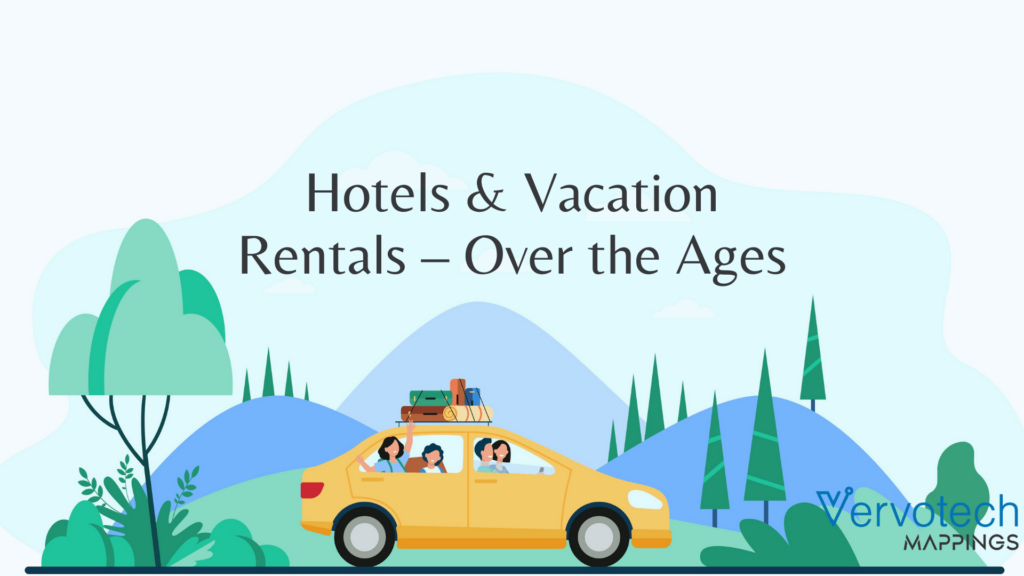Since humans started settling in colonies and gradually shifted from a nomadic tribe to a farming one, there was a need for people to travel between these colonies for trade, art, culture and commerce. As civilizations grew widespread, so did the distances that needed to be traversed between major cities thus majorly affecting the time taken to travel. The hospitality industry as a sector started providing rest houses such as monasteries and abbeys to these weary travellers that were either controlled by the state and paid for by the people through taxes or religious groups that supported them through offerings. However, as volumes increased and in cases where the state was unable to fund these rest-houses, ownership was transferred to private entities. These rest-houses ranged from simple cottages to large multi-storied buildings complete with their bath and gardens. Some records show that the Romans even build mansions for travellers that were on the road for official government business.
Seeing the lucrative business opportunities in the sector, several individual businessmen started renting out their summer homes and plots of land to vacationers for a little extra income on the side. Since travel relied heavily on the terrain and the weather, most routes were seasonal thus allowing these businessmen to enjoy their settlements at designated times of the year. As newer modes of transport were introduced, these summer-houses were gradually shifted to a perennial business thus giving birth to the very early concept of vacation rentals. It is important to understand that hospitality, as a business was already prevalent in major capitals of the world and hotels, were a widespread concept even during the early days of civilization, although they were known by different names over the ages. Therefore, these early models of ‘vacation rentals’ were generally owned by wealthy individuals who had access to land and could afford multiple living spaces thus giving them the liberty to rent out their living spaces to tourists.
Since these vacation rentals were quite furnished, the owners would rent out these places at their discretion usually at a higher price when compared to hotels due to their added amenities. These spaces would generally be located at tourist spots where wealthy families spent their vacations and were able to afford such lavish services. So, the main differences between hotels and vacation rentals were quite distinguished even during the early days of civilization as they are today. While hotels were much more accessible to all types of travellers, vacation rentals were more or less targeted towards tourist minded individuals. It is also important to note that travel and tourism were considered more of luxury back in the day, reserved more or less for the upper classes. Therefore, tourists were mainly wealthy families while travellers on the other hand were the class of people that travelled for a purpose. Not much has changed today except for the fact that travel and tourism have become much more affordable and accessible thus making both vacation rentals and hotels a viable choice for tourists and travellers alike.Many studies suggest that the history of hotels is intricately linked to that of civilizations with the hospitality industry being moulded by purpose rather than profit. Being a core service industry, the sector needed to concentrate more on its quality of service rather than profit. This resulted in a rather stagnated rate of growth in the middle ages with innovations being made only when required. Inns were quite popular during this time in Europe and provided a much-needed place of rest for weary caravanners, one of the most widespread and uncomfortable modes of transport ever created. These inns had stables attached to them that made changing the horses and feeding them easier but resulted in a bad stench all over the place. With the number of travellers on the rise and no profits to support them, these inns became more and more crowded and hazardous to the travellers with sanitization levels at an all-time low. Some of the better-known inns during this time were the l’ Auberge des Trois Rois in Basle, l’ Auberge Cour Saint Georges in Gant and the Angel Inn from Grantham in Lincolnshire, England.
A major shift in the industry was noticed when inns started offering additional services to travellers to build up profits. This led to the introduction of food, or more specifically, meals to the travellers where accommodation and food would be sold as a package in an attempt to make up for losses. Due to the rising hazards in these inns and inhospitable conditions offered by them, a law was introduced in the 15th century that required all hotels and inns to be registered with a license. This introduced various challenges in an industry that was previously unregulated and hotels and inns scrambled to ‘clean’ up their act to save their business. While the quality of service offered by these accommodation providers grew, so did the costs leading to a wide variety of types of ‘hotels’ depending on the service that they provided. Some were targeted towards wealthy individuals and provided a variety of services while others were more direct in their service. This was the birth of the wide classification of types of accommodation that we come across today. Hobby travellers also found their footing during this time with the first guidebooks for tourists being published in France in the 16th century.
The 19th and the 20th century are generally considered as the golden age of travel and hospitality with hotels like the Le Grand Hôtel Paris and the Palmer House Hotel opening their doors for the first time to patrons. These hotels were known for their grandeur and luxury and were only accessible by the wealthy, usually familiar faces. In 1873, the Palais de Würtemberg in Vienna was transformed into the incredible l’Hôtel Impérial, a much-frequented place by kings and generals most well-known for its representation of the refined architecture of the Ringstrasse in Vienna. This trend of hotels trying to outmatch one another continued till the 1910s when the onset of the two global wars more or less put a stop to the travel and hospitality industry. Some notable ones were still built tough, with the most famous one perhaps being the Waldorf Astoria in New York, which remains a towering edifice to the troubled times brought about by the terrible economic depression of 1929. The end of the second world war brought an end to hotels trying to outdo one another in terms of grandeur and focused more on comfort and luxury.
The 1960s and the 1970s was a sort of renaissance for the travel and tourism industry with people hungry for a little sunshine after recovering from the post-effects of World War II. Many new tourist destinations opened up in Hawaii, the Spanish coast and South East Asia thus driving the hospitality industry in the process. The 1970s saw the construction of hotels geared specifically towards the businessmen, a growing class at the time. These were lavish resorts with state-of-the-art facilities and services but charged a premium price for their effort. A quainter alternative were holiday homes that were rented out to families or large groups of tourists where they could do as they please – the first iteration of modern vacation rentals. These spaces are sparsely furnished allowing large groups of families or people to stay together in relatively small spaces but allowed for a lot of outdoor activities such as horse-riding, hiking and camping. Located in strategically targeted areas, these provided a lot more freedom to tourists than hotels as one essentially rents out the place to a group rather than booking one single room with other people as neighbours. These vacation rentals ranged from farm-houses to villas depending on the location thus providing an alternate experience to tourists when compared to hotels.Alternate accommodation providers, as they have come to be known, have become extremely popular over the last 30 years mainly due to rapid advancements in the travel and communication industry. The advent of the internet during the 80s and the subsequent spread of it during the 90s influenced a major change in the travel and hospitality industry. Companies and individual property owners became increasingly aware of the power of the internet and its ability to launch businesses if used properly. As a result, several travel agencies started cropping up online during the latter half of the 90s. Travelocity by SABRE is often credited as the first online travel agency followed closely by Expedia, an initiative by Microsoft.
Most of these travel agencies worked independently using their in-house technologies. Online e-commerce platforms were in their infancy and there were no strict standards that were needed to be followed when booking online. The early 2000s saw the rise of technology companies that were fast working towards consolidating data and setting standards in the industry. While the 90s might have given birth to the era of the internet, it was the 2000s that gave it life. People increasingly became reliant on the internet and more and more businesses started focusing on building their online presence. It was during this time that alternate accommodation providers found their footing.
Since hotels were the standard choice for tourists, alternate accommodation was more or less geared towards seasoned travellers and adventurers that were looking for a different experience than that provided by regular hotels. Therefore, alternate accommodation providers also had to position their listings accordingly. However, with the popularization of the internet, these alternate accommodation providers could make their services more readily available to regular tourists and travellers. Accessibility and visibility were two key aspects that were required to push this industry forward and that was exactly what the internet provided!
With the presence of accommodation providers, both regular and alternate, steadily growing on the internet, suppliers started focusing on making these listings available to travel agencies to capitalize on the boom of the internet. Noticing such changes, many individual property owners started listing their properties on such online platforms to build on profits. This led to an increase in the types of accommodation available to travellers as people were not only listing their apartments and rooms but also listing their villas, bungalows and condos. As the visibility of such properties grew, people started noticing the various experiences that such places offered. Alternate accommodation quickly became a trend among travellers, tourists and adventurers alike thus leading to many online travel agencies pushing such alternate choices on their platforms.
Recommended: Five Ways World Travel Industry Digitalizing Journeys
The rise of the smartphone industry also played a major role in boosting travel and tourism and in turn, hospitality. People no longer required setting up a hefty system to access the internet, they could simply access it through their smartphones from the comfort of their beds. Social media became the new craze and this opened up a lot of newer channels for companies to connect with their potential customers. Search engines were reliable and provided not only easy access to information but also a platform on which companies could potentially reach customers. This, in turn, allowed consumers certain freedom of choice when it came to availing products where they could make informed decisions by reading reviews on the internet.
Recommended: Five Emerging Technology Trends in Travel Industry
It is essential to understand that while the internet provided a very intuitive channel to reach potential customers, it also increased the overall competition within the market. Companies needed to be more aware of their competitors and analyze the various needs and wants in the markets to orient their products effectively and remain viable. Products needed to be premium, prices needed to be competitive and the service, impeccable if companies wanted to maintain a high review score on the internet. This led to a rise in a slightly different type of online accommodation provider, one that promised to change the entire game.Founded in 2008 by Brian Chesky, Nathan Blecharczyk and Joe Gebbia, Airbnb started as an alternative to regular online hotel booking platforms where they offered quarters on rent to people in need for those who could not book hotels. During the economic crisis of 2008, people found it difficult to book hotels in a market where property prices were through the roof. Airbnb, originally Airbedandbreakfast, quickly grew due to its unique business model and enabled alternate accommodation providers with a dedicated platform to showcase their properties. People could easily access these vacation rentals at ease through the online portal that not only provided all the information regarding the listing but also attractive discounts that attracted a wide range of audiences.
Seeing the popularity of Airbnb, a lot of newer companies started adopting the same model of business such as HomeToGo and Vrbo, each introducing their technologies and business models into the mix. A lot of newer property types started being listed such as cabins, cottages, studios, townhouses, villas, condos, resorts, lodges, chalets, caravans, estates, farmhouses, boathouses, barns and even castles. This allowed travellers to access a wide range of properties according to their need, purpose and intended experience. Property owners could also rent out their properties according to their needs. All in all, it proved to be an extremely viable concept that has completely transformed the hospitality industry in a modern context.One of the main challenges that have plagued the hospitality industry over the last couple of decades is content management. Since the number of players and the number of customers is constantly on the rise, there is a need for a certain standard when it comes to content distribution. However, the hospitality industry has never had a standard for consolidating and pushing content that has led to a lot of duplicate and erroneous listings on various platforms. Usually, online travel agencies work with multiple suppliers who are all delivering data using their algorithm and the travel agency must filter all that incoming content for duplicates and errors. Various companies have incurred huge losses not only due to incorrect data being posted on their platforms but also due to lawsuits arising from incorrect bookings that have led to harassment on part of the traveller. The loss in brand value and image in such cases hurt the company more than the losses incurred through settlements. Therefore, there is a need for companies to develop and adopt newer technologies that can quickly and efficiently map all incoming data so that the listings provided on online platforms are up-to-date and accurate.
We, at Vervotech, believe in the power of technology to solve challenges and are working hard to address this very need. Leveraging the power of AI and ML, we developed and launched our first product, Vervotech Mappings, in the year 2018 with a wide coverage of 98% and an unmatched accuracy of 99.999%. Click here to learn more about the ways Vervotech Mappings are helping both suppliers and online travel agencies manage their content and ensure their viability in the long run.[/vc_column_text][/vc_column]
About Vervotech Mappings:
Vervotech Mappings is a leading Hotel Mapping and Room Mapping API that leverages the power of AI and ML to quickly and accurately identify each property listing through the verification of multiple parameters. With one of the industry’s best coverage of 98% and an accuracy of 99.999%, Vervotech Mappings is quickly becoming the mapping software of choice for all leading global companies operating in the travel and hospitality industry. To learn more about Vervotech Mappings and the ways it can enhance your business in the long run contact us: sales@vervotech.com







